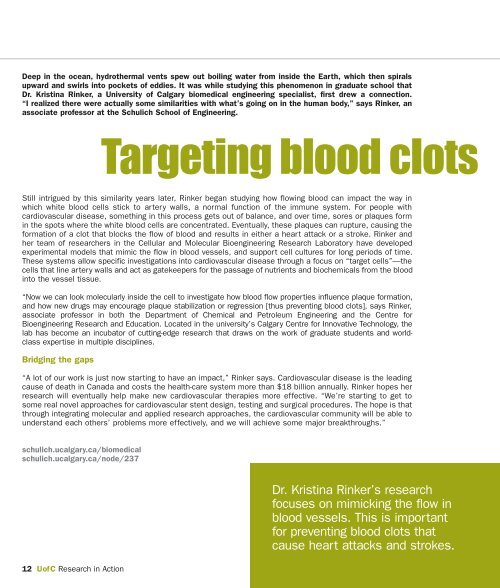Research in Action: - University of Calgary
Research in Action: - University of Calgary
Research in Action: - University of Calgary
Create successful ePaper yourself
Turn your PDF publications into a flip-book with our unique Google optimized e-Paper software.
Deep <strong>in</strong> the ocean, hydrothermal vents spew out boil<strong>in</strong>g water from <strong>in</strong>side the Earth, which then spirals<br />
upward and swirls <strong>in</strong>to pockets <strong>of</strong> eddies. It was while study<strong>in</strong>g this phenomenon <strong>in</strong> graduate school that<br />
Dr. Krist<strong>in</strong>a R<strong>in</strong>ker, a <strong>University</strong> <strong>of</strong> <strong>Calgary</strong> biomedical eng<strong>in</strong>eer<strong>in</strong>g specialist, first drew a connection.<br />
“I realized there were actually some similarities with what’s go<strong>in</strong>g on <strong>in</strong> the human body,” says R<strong>in</strong>ker, an<br />
associate pr<strong>of</strong>essor at the Schulich School <strong>of</strong> Eng<strong>in</strong>eer<strong>in</strong>g.<br />
12 U<strong>of</strong>C <strong>Research</strong> <strong>in</strong> <strong>Action</strong><br />
Target<strong>in</strong>g blood clots<br />
Still <strong>in</strong>trigued by this similarity years later, R<strong>in</strong>ker began study<strong>in</strong>g how flow<strong>in</strong>g blood can impact the way <strong>in</strong><br />
which white blood cells stick to artery walls, a normal function <strong>of</strong> the immune system. For people with<br />
cardiovascular disease, someth<strong>in</strong>g <strong>in</strong> this process gets out <strong>of</strong> balance, and over time, sores or plaques form<br />
<strong>in</strong> the spots where the white blood cells are concentrated. Eventually, these plaques can rupture, caus<strong>in</strong>g the<br />
formation <strong>of</strong> a clot that blocks the flow <strong>of</strong> blood and results <strong>in</strong> either a heart attack or a stroke. R<strong>in</strong>ker and<br />
her team <strong>of</strong> researchers <strong>in</strong> the Cellular and Molecular Bioeng<strong>in</strong>eer<strong>in</strong>g <strong>Research</strong> Laboratory have developed<br />
experimental models that mimic the flow <strong>in</strong> blood vessels, and support cell cultures for long periods <strong>of</strong> time.<br />
These systems allow specific <strong>in</strong>vestigations <strong>in</strong>to cardiovascular disease through a focus on “target cells”—the<br />
cells that l<strong>in</strong>e artery walls and act as gatekeepers for the passage <strong>of</strong> nutrients and biochemicals from the blood<br />
<strong>in</strong>to the vessel tissue.<br />
“Now we can look molecularly <strong>in</strong>side the cell to <strong>in</strong>vestigate how blood flow properties <strong>in</strong>fluence plaque formation,<br />
and how new drugs may encourage plaque stabilization or regression [thus prevent<strong>in</strong>g blood clots], says R<strong>in</strong>ker,<br />
associate pr<strong>of</strong>essor <strong>in</strong> both the Department <strong>of</strong> Chemical and Petroleum Eng<strong>in</strong>eer<strong>in</strong>g and the Centre for<br />
Bioeng<strong>in</strong>eer<strong>in</strong>g <strong>Research</strong> and Education. Located <strong>in</strong> the university’s <strong>Calgary</strong> Centre for Innovative Technology, the<br />
lab has become an <strong>in</strong>cubator <strong>of</strong> cutt<strong>in</strong>g-edge research that draws on the work <strong>of</strong> graduate students and worldclass<br />
expertise <strong>in</strong> multiple discipl<strong>in</strong>es.<br />
Bridg<strong>in</strong>g the gaps<br />
“A lot <strong>of</strong> our work is just now start<strong>in</strong>g to have an impact,” R<strong>in</strong>ker says. Cardiovascular disease is the lead<strong>in</strong>g<br />
cause <strong>of</strong> death <strong>in</strong> Canada and costs the health-care system more than $18 billion annually. R<strong>in</strong>ker hopes her<br />
research will eventually help make new cardiovascular therapies more effective. “We’re start<strong>in</strong>g to get to<br />
some real novel approaches for cardiovascular stent design, test<strong>in</strong>g and surgical procedures. The hope is that<br />
through <strong>in</strong>tegrat<strong>in</strong>g molecular and applied research approaches, the cardiovascular community will be able to<br />
understand each others’ problems more effectively, and we will achieve some major breakthroughs.”<br />
schulich.ucalgary.ca/biomedical<br />
schulich.ucalgary.ca/node/237<br />
Dr. Krist<strong>in</strong>a R<strong>in</strong>ker’s research<br />
focuses on mimick<strong>in</strong>g the flow <strong>in</strong><br />
blood vessels. This is important<br />
for prevent<strong>in</strong>g blood clots that<br />
cause heart attacks and strokes.

















